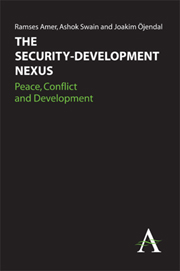Book contents
- Frontmatter
- Contents
- List of Tables and Figures
- List of Editors and Contributors
- Acknowledgements
- Chapter 1 Researching the Security-Development Nexus through a Multi-disciplinary Approach
- Chapter 2 Exploring the Security-Development Nexus
- Chapter 3 Liberal State-Building and Environmental Security: The International Community between Trade-Off and Carelessness
- Chapter 4 The Rising China and Maintaining the International Order: Some Reflections
- Chapter 5 Non-use of Force, Non-interference and Security: The Case of Pacific Asia
- Chapter 6 International Dimensions of Peace Processes in Aceh and Sri Lanka: The Role of Intermediaries in the 2000s
- Chapter 7 The Challenges of Human Security and Development in Central Asia
- Chapter 8 Diasporas' Role in Peacebuilding: The Case of the Vietnamese-Swedish Diaspora
- Chapter 9 Tracing Minerals, Creating Peace: The Security-Development Nexus in the DRC
- Chapter 10 Water Management and the Security-Development Nexus: The Governing of Life in eThekwini Municipality, South Africa
Chapter 6 - International Dimensions of Peace Processes in Aceh and Sri Lanka: The Role of Intermediaries in the 2000s
Published online by Cambridge University Press: 05 June 2012
- Frontmatter
- Contents
- List of Tables and Figures
- List of Editors and Contributors
- Acknowledgements
- Chapter 1 Researching the Security-Development Nexus through a Multi-disciplinary Approach
- Chapter 2 Exploring the Security-Development Nexus
- Chapter 3 Liberal State-Building and Environmental Security: The International Community between Trade-Off and Carelessness
- Chapter 4 The Rising China and Maintaining the International Order: Some Reflections
- Chapter 5 Non-use of Force, Non-interference and Security: The Case of Pacific Asia
- Chapter 6 International Dimensions of Peace Processes in Aceh and Sri Lanka: The Role of Intermediaries in the 2000s
- Chapter 7 The Challenges of Human Security and Development in Central Asia
- Chapter 8 Diasporas' Role in Peacebuilding: The Case of the Vietnamese-Swedish Diaspora
- Chapter 9 Tracing Minerals, Creating Peace: The Security-Development Nexus in the DRC
- Chapter 10 Water Management and the Security-Development Nexus: The Governing of Life in eThekwini Municipality, South Africa
Summary
Introduction
When the government of Indonesia and the Free Aceh Movement (Gerakan Aceh Merdeka, GAM) signed the Helsinki peace agreement in 2005, as many as thirty years had passed since the armed conflict in Aceh started. Likewise in Sri Lanka, the civil war between the government and the Liberation Tigers of Tamil Eelam (LTTE) had been raging for more than two and a half decades when the government declared victory in 2009. The prolonging of these two conflicts is striking, and still they are merely two out of a number of civil wars that have lasted for several decades, causing widespread human suffering with numerous casualties and socio-economic losses.
As many of today's armed conflicts tend to be long lasting, they often have a noteworthy track record of peace attempts. At an international glance, efforts to reach a negotiated settlement to armed conflicts have increased in the last decades and nowadays engage a variety of both state and non-state actors (see Ramsbotham, Woodhouse and Miall 2005; Wallensteen 2007). In Aceh, however, it was not until the beginning of the 2000s – more than two decades after the armed conflict started – that the conflict gained international attention while carrying out peace attempts. Also in Sri Lanka, the peace attempts made in the 2000s reached a new dimension of internationalization (Goodhand and Klem 2005, 88).
- Type
- Chapter
- Information
- The Security-Development NexusPeace, Conflict and Development, pp. 111 - 136Publisher: Anthem PressPrint publication year: 2012



